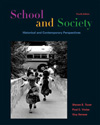Unlike the three preceding chapters, Chapter 5 examines school and society in several historical eras, from the colonial through the Progressive periods. What is more, each of these periods has already been treated in Chapters 2 to 4. Yet this chapter is not a review. It is a focusing of attention on an issue that has appeared too briefly in the preceding chapters: the education of girls and women. Because the political-economic dimensions of these historical eras were drawn in early chapters, Chapter 5 begins with a discussion of the ideological origins of the differential treatment of girls and women in society. These ideological roots were in part religious. As the chapter notes very early, it should not be surprising that a nation founded by religious dissenters should show deep religious influences in its political thought and values. Relying on the critically acclaimed work of historian Elaine Pagel, we begin with a brief discussion of how early Christian tradition has contributed to justifying differential expectations for men and women in society and in schooling. The chapter traces the development of schooling for girls and women from colonial times through the post-Revolutionary period, the nineteenth century, and then through the major part of the Progressive Era. In each of these periods, prevailing forms (and absences) of schooling for girls and women are examined in the context of shifts in views about women’s roles in society and the proper preparation for those roles. In the colonial period, the relative absence of girls from schools reflects the dominant view of women that discouraged intellectual development. In the post-Revolutionary period, contrasts between boys’ schooling and girls’ schooling show increasing schooling arrangements for girls, but within specific boundaries of preparation for "feminine" work. Emma Willard’s Troy Seminary is shown to be an early-nineteenth-century contribution to expanding the educational and professional possibilities for women. By mid-nineteenth century, competing viewpoints on the role and education of girls and women had sharpened into identifiable ideological positions–conservative, liberal, and radical–each of which bears antecedents in classical liberalism. This discussion of ideological heterogeneity among women is sharply illustrated by the two Primary Source Readings at chapter’s end, one of which, the Seneca Falls Declaration of 1848, is briefly referenced in the chapter. Nineteenth-century approaches to the higher education of women are discussed, including academies, normal schools, colleges, and even high schools. As the twentieth century approached, the vocational education movement discussed in Chapter 4 took on particular significance for the education of girls and women in secondary school. Progressive Era initiatives in domestic science and in commercial education focused on preparing girls for gender-typed occupations. The Mary Leal Harkness selection at chapter’s end presents a Progressive Era critique of such vocationalist thinking. |



 2002 McGraw-Hill Higher Education
2002 McGraw-Hill Higher Education